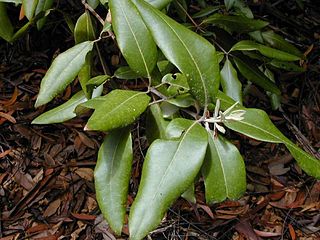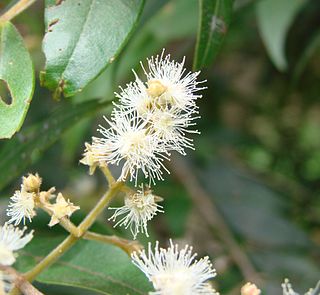
Psidium is a genus of trees and shrubs in the family Myrtaceae. It is native to warmer parts of the Western Hemisphere.

Syncarpia is a small group of trees in the myrtle family (Myrtaceae) described as a genus in 1839. They are native to Queensland and New South Wales in Australia.

Campomanesia is a genus in the family Myrtaceae described as a genus in 1794. It is native to South America and Trinidad.

Myrcia is a genus of the flowering plant family Myrtaceae described as a genus with this name in 1827. As of 2015 it contains about 770 species. They are distributed in Central and South America, Mexico, and the West Indies.

Plinia is a genus of flowering plants in the myrtle family, Myrtaceae described by Linnaeus in 1753. It is native to Central and South America as well as the West Indies.
Amomyrtella is a genus of flowering plants in the myrtle family, Myrtaceae, first described as a genus in 1956. It is native to South America, where it is distributed from Ecuador to Argentina.
- Amomyrtella guili(Speg.) Kausel, Ark. - S Bolivia, NW Argentina
- Amomyrtella irregularis(McVaugh) Landrum & Morocho - Loja Province in Ecuador

Amomyrtus is a genus of flowering plants in the myrtle family, Myrtaceae described as a genus in 1948. It is native to temperate southern South America, where it is distributed in Chile and Argentina.
Chamguava is a genus of the botanical family Myrtaceae, first described as a genus in 1991. It is native to southern Mexico and Central America.
- Chamguava gentlei(Lundell) Landrum - Chiapas, Belize, Guatemala, Honduras
- Chamguava musarum(Standl. & Steyerm.) Landrum - Guatemala
- Chamguava schippii(Standl.) Landrum - Guerrero, Chiapas, Belize, Guatemala, Panama

Blepharocalyx is a genus of plant in family Myrtaceae first described as a genus in 1854. It is native to South America and the West Indies.
- Blepharocalyx cruckshanksii(Hook. & Arn.) Nied. - Chile
- Blepharocalyx eggersii(Kiaerskou) L.R.Landrum - Lesser Antilles, Venezuela, Guyana, Peru, Brazil
- Blepharocalyx myriophyllus Mattos - Minas Gerais
- Blepharocalyx salicifolius(Kunth.) O.Berg - Brazil, Bolivia, Peru, Ecuador, Paraguay, Uruguay, N Argentina
Mitranthes is a genus of plant in the family Myrtaceae described as a genus in 1856. It is native to Cuba and Jamaica in the West Indies.
- Mitranthes clarendonensis(Proctor) Proctor - Jamaica
- Mitranthes glabraProctor - Jamaica
- Mitranthes macrophyllaProctor - Jamaica
- Mitranthes maxonii(Britton & Urb.) Proctor - Jamaica
- Mitranthes niveaProctor - Jamaica
- Mitranthes ottonisO.Berg - W + C Cuba
- Mitranthes urbanianaBurret - Jamaica
Neomitranthes is a genus of plant in family Myrtaceae first described as a genus in 1977. The entire genus is endemic to Brazil.
Myrteola is a plant genus in the Myrtaceae described as a genus in 1856. It is native to South America and the Falkland Islands.
Barongia is a genus of flowering plants in the myrtle family, Myrtaceae first described as a genus in 1988. It contains only one known species, Barongia lophandra, endemic to the Cook region of Queensland, Australia.
Legrandia is a genus of the plant family Myrtaceae, first described as a genus in 1944. It contains only one known species, Legrandia concinna, endemic to the Republic of Chile in South America.
Neomyrtus is a genus of plants in the family Myrtaceae described in 1941. It contains only one known species, Neomyrtus pedunculata, endemic to New Zealand. It is found there on both the North Island and the South Island.

Pleurocalyptus is a group of shrubs and small trees in the family Myrtaceae, first described as a genus in 1868. The entire genus is endemic to New Caledonia. It is closely related to Xanthostemon.
Purpureostemon is a genus of plant in the myrtle family Myrtaceae described as a genus in 1939. There is only one known species, Purpureostemon ciliatus, endemic to New Caledonia. Purpureostemon is related to Xanthostemon.

Siphoneugena is a genus of the botanical family Myrtaceae, first described as a genus in 1856. It is native to Central and South America as well as the West Indies.
Whiteodendron is a genus of plant in family Myrtaceae described as a genus in 1952. It contains only one known species, Whiteodendron moultonianum, endemic to Borneo.

Myrteae is the largest tribe in the plant family Myrtaceae. It includes most of the species of the family that have fleshy fruits.









